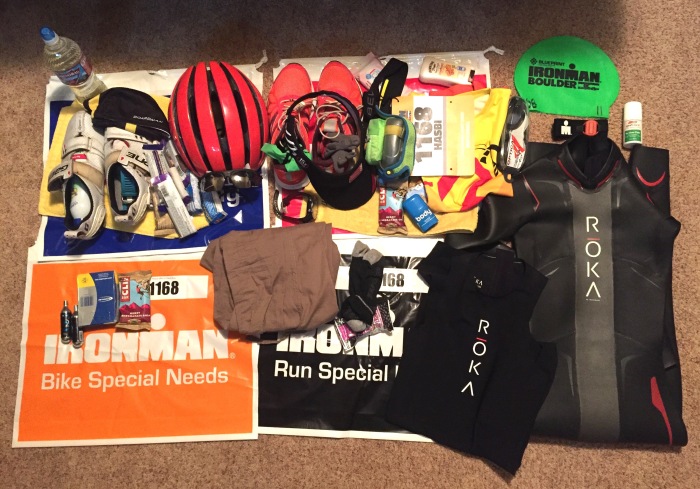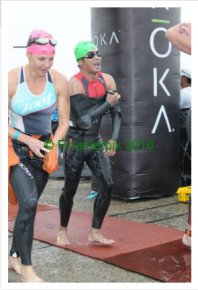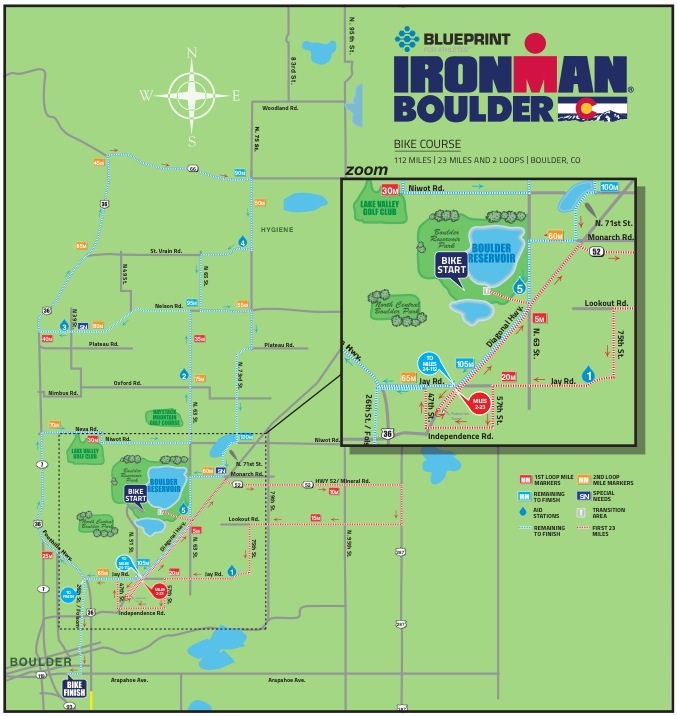Before I completed and published my first post “Triathlon Project 2015”, I already set my eyes on my would be the second Ironman race. The choice was easy, as by then my son was pretty much set his mind on studying at Colorado School of Mines. Hence, the Ironman Boulder is the one to go, a little over a week before he starts his uni.
This event is not the toughest, of course, but still a hard one, considering the altitude of 1660m + above sea level, fresh water swim, hilly bike route, and undulating run course. The training starts by second week of March to allow for 16-17 weeks of meaningful preparation with 11-16 hours per week training for swim, bike, run, and strength/flexibility. Very similar backbone to that for Busselton but with more focus on improving the swim for a possible non-wetsuit ruling, fresh water, windy swim, and definitely for that challenging bike route.
The Altitude thing
As expected, many suggested me to train on the higher ground in Indonesia, such as Bandung, Pengalengan, etc. As usual, I trust my own research. Here are some of the findings. Bear with me as this part may be the longest of this posting.
– Accute mountain/altitude sickness may kick in for folks from sea level going to 2000m and above. However, altitude as high as 1000m may have introduced difficulties in breathing already. Sea level oxygen is arround 21% of the air we breathe, while Boulder has around 16-17%; it is not dangerously low, but more than enough to cause problems from heavy breathing, elevated heart rate, etc, to blood thickening.
– The other issue is air pressure, that is combined with lower oxygen level will push for the need of frequent and deeper breathing, that in return will elevate heart rate and cause dehydration. Keeping the body hydrated is then the main key, and can easily be overlooked even in the mountain summer heat of 39-42 degC as sweat is evaporating very quickly as if you are not sweating at all, giving the false impression that you are well hydrated.
– The principle of “Live High Train Low” that adopted by many pro triathletes living in Boulder as their basecamp. Basically, the underlying theory is that by having less oxygen in air, the body will slowly adapt to the hypoxic situation by instructing kidneys to produce more Erithropoietin (EPO) during sleep to carry more red blood cells. EPO, as external substance, is illegal, and dangerous, but if produced by body naturally, it is quite a potent drug that will remain in effect days or to couple of weeks even after leaving high altitude to sea level. Therefore, these athletes normally live in higher altitude to get more EPO naturally during their sleep, and train at lower altitude, and straight to races all over the world to get the maximum benefits.
– By the last point, there is no reason for me to train in Pengalengan, for example, other than just experiencing heavy breathing and sub-optimum intensity. I have to live in Pengalengan and fly direct to Boulder for the race, to make it useful. I cannot afford that due to work and family commitment, of course. So, just train in Bintaro, forget about higher places, go to Boulder 7-10 days before the race, take it easy and sleep well, and let the body handles the EPO production. It works.
The Training

For the training, I combine the upper body approach by Akbar Nasution and the lower body and kicking strength basic of Sonny Kaunang. Swimming is still my weakest link, hence I need the expertise of these two gentlemen. For cycling, I still rely on my “dumb trainer” (as opposed to now more available smart interactive ones), with more sessions of uphill interval and uphill tempo indoor. I do not think that cycling to other places than Bintaro is safe enough. Even in Bintaro I grow more worried riding outside. On technical side, I would benefit more from having power meter for my training, but I decided not to invest in this yet, due to cost-benefit assessment in the middle of the training. However, for those can afford power meters, I would highly recommend to utilize it fully.
Running is a little bit problematic, as early in the training period I would have to run in London Marathon, in April. Normally, that early stage would not see high mileage necessary for a marathon piled up yet, and it was not. At the end, I still run London Marathon reasonably ok.
Nutrition during training is also unchanged, with focus on clean and healthy diet, and usual supplements such as omega-3 and fish oil, healthy fat from almond milk and almond, anti-oxidants from fruits such as beetroot, etc. My training still predominantly done under fasted state with the exceptions of longer bricks, where I simulate intakes for the race.
The pre-race
Ironman Boulder race director, Dave “DC” Christen, has been a superb guy. He and
team issued in total of six 13-15 minutes videos covering the race guide in detail, from pre-arrival, registration and check-in, swim, bike, run, and spectators guide way in advance, and answers many questions from participants. This is the example of directing an event properly. Everything went smooth with helps of over 2,500 volunteers. Great efforts from everybody. Registration, run gear check-in, bike check-in, all went well.

I arrived in Boulder around eight days before the event. I was also very lucky to be introduced to Nita Permatasari, an Indonesian lady living in Boulder, a cycling enthusiast, and a mountain goat in this sense. She showed me the key challenges in bike route, and practically she was an excellent ground support including dropping me off to Boulder Reservoir at 3 in the morning and picking me up late evening.
I took the adaptation days very easy with short jogging sessions. I tried out swimming in Boulder Reservoir four days before the event. It was summer but water temperature was still below 76 degF (24 degC), below wetsuit legal cutoff. The race committee kept measuring the temperature and will decide on the race day whether it is wetsuit or non-wetsuit event.

The race day
The swim

A warm summer morning, but cold reservoir. Water temp was at 72degF (22degC), so wetsuit was up. It was a rolling wave start, as oppose to mass start in Busselton. I self-seeded myself to 1:30-1:45 swimmers. After the national anthem of Star Spangled Banner, off we went. Boulder Reservoir was fresh water – wetsuit buoyancy hence helped – but murky with almost zero meter visibility. Self seeding worked well here, unlike in Asia where slower swimmers tended to start in faster corral, giving troubles to other participants later in the middle of the course. Wetsuit did give me advantage, but what was better in Boulder compared to Busselton (also wetsuit event, salt water for added buoyancy) is the absence of choppy water. Nevertheless, the challenge was the navigation, as now the big Busselton jetty that was always on my left hand side was absent in Boulder. More frequent sightings did introduce frequent ministops in my freestyle. Other than that, no issue. My more stable strokes, fuller and more relaxed pulls, and stronger two-flutter kicks resulted in 1:33 time for 4.1km swim, compared to 1:52 for 3.9km swim in Busselton. I have Akbar Nasution and Sonny Kaunang to thanks for this improvement. For coach Sonny: I started giving up swimming in January – you know the rest of the story.
Nutrition on the swim: light breakfast of bread and bars around 2-2.5 hours before swim, and half a bar (around 50-75 kcal) after. I estimated my calori requirement of around 200-250 kcal for this swim.

The bike

After a long walk from swim finish to changing chute and to the bike rack, the interesting bike leg was started. The first small loop was supposed to be the hardest with long climb at the Lookout road, and facing the “Three bitches” ie three climbs in succession with no rolling. Afterward, we proceeded to the first two bigger loops, with variation of long climb and fast decents, with its infamous and deceitful Nelson road uphills. I do not like climbing, but I like rolling hills. Taking it easy on climbs – down to 10kph ride and less – and giving it out on the downs; it was a good ride, with temperature creeping up, very dry, but not too hot for a tropic folks like me. Total elevation gain of 1.25km. I completed the bike leg in 6:15, three minutes faster than Busselton bike leg (a flat fast course with drizzles and quite a strong headwind). It was not easier, but I think I get stronger.
Sad news during the bike leg. A 34 year-old triathlete from Nebraska was involved in fatal accident with a car quite early in the race. The road was not blocked for this event, as in the previous two years, but with marked and coned lines. I passed her already lying on the asphalt, but now could not exactly remember her position or any other info that may help police investigation of the accident. Look it up on the web from more updates.
Nutrition on the bike: alternating gels and bars (ea around 130-140 kcal) per hour, and additional 60-100 kcal from electrolytes drink taken very frequently, at thirst. My estimates calory requirement for 6-7 hours cycling under this duress is around 1400-1600 kcal, with additional calories required to combat fatigue from climbs, and lots of liquid to tackle more than usual dehydration. I tried to limit calories intake of maximum around 250-300 kcal per hour, my estimate of the amound my body can digest and absorb without leaving too much sugar upsetting my stomach. I also refrained from using intakes with caffeine as it may elevate my heart rate that would already be high due to altitude and dryness.
The run

I felt very fresh and well off the bike. I started running easy with moderately faster pace (for me) at around 5:30-6:30 min/km. Faster swim leg and faster bike leg than previous Ironman, and the seemingly working nutritional intake with no signs of legs cramping kept my spirit high for the run. It did not last long, though. At around km 5, I felt sharp pain at the outer side of my back, left and right. It was painful to breathe deep. I then walked and slow jog until km 28, and completely power-walk from then on, and short run again closer to finish line.
It could very well be that my back was too tense during the bike leg (bike fitting issue? after all this time?), weak back core, sudden jerking movement during the early running, or gas trapped in digesting system. I am still yet to see the answer to it. From 4:29 in Busselton to 6:05 in Boulder, it was a bit of a blow to my confidence. However, I managed to finish the race without any other problem. Mike Reilly, the voice of Ironman (he has been welcoming more than 200,000 Ironman finishers with the famous “You Are an Ironman” since 1989), greeted me at the finish line. What a big honour, even though he mistakenly mentioned that I am from India, twice. I guess IND, IDN, INA, and all these non-standard country abbreviation mixes things up.
Nutrition on the run: water, electrolytes, degassed cola, fruits, and chips as source of sodium. I rely on the quality of the intake during the bike leg to keep the running easy, and then maintain it to avoid bonking. Estimated total calories requirement of 1400-1700 kcal.
Closing the Report
Yes, it is not as emotional as my first Ironman race (and report). The message remains the same: Discipline and commitment, value of family and friendships, and Anything is Possible. In swim and bike legs, it did not get easier, but I got smarter. Also, there is always one or two thing that you can work out for the future, keeping you humble.
Afterward, I enjoyed the time in Colorado, recovering the body and mind. Anyone want to guess what I have in mind for my next long distance triathlon?

In addition to those already mentioned, I am thanking all individuals and groups, in particular Bintaro Trojan Runners family, that making this possible, and definitely my wife and son to still allow me to pursue this Ironman lifestyle.








